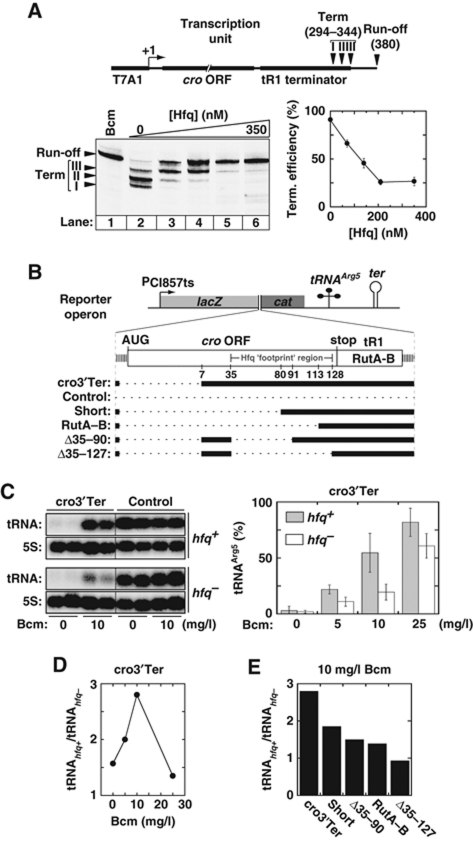Figure 2.
Hfq-mediated transcriptional antitermination. (A) Effect of Hfq on in vitro Rho-dependent transcription termination at the tR1 terminator. The composition of the DNA template (pT7A1-λcro) used in the in vitro transcription experiments is schematically depicted at the top of the panel. Gel bands corresponding to transcripts terminated at the canonical sites I, II, and III and to RNAP read-through of the terminator (Run-off transcripts) in the presence of 70 nM Rho are identified by arrowheads on the left side of the gel. The graph shows the global termination efficiency (sites I, II, and III) as a function of Hfq concentration. Bcm is a Rho-specific inhibitor. (B) A schematic of the reporter operons used in in vivo experiments. The thick black lines show which parts of cro-tR1 are present in the various operons. (C) Hfq reduces Rho-dependent tR1 termination in vivo in the presence of subinhibiting Bcm concentrations. Northern blots show tRNAarg5 and 5S RNA accumulation in hfq+ or hfq− cells carrying plasmid pOM10cI (Control operon) or pOM10cI-cro3′Tert (cro3′Ter operon). Total RNA was extracted from two different cultures in each case. Blots were successively hybridized with tRNAArg5 and 5S RNA probes. Blots separated by dotted lines are from the same membranes and were phosphor-imaged simultaneously. Histograms show normalized tRNAArg5 amounts (mean±error from 4–6 independent samples) in cells carrying the pOM10cI-cro3′Ter (cro3′Ter) plasmid. In each case, normalization assumes that 100% of tRNAArg5 is formed in the strain carrying the control pOM10cI plasmid. (D) Ratios of tRNAArg5 accumulated in hfq+ and hfq− cells from the cro3′Ter operon as a function of Bcm concentration. Bcm was added to culture media at the time of induction. (E) Ratios of tRNAArg5 accumulated in hfq+ and hfq− cells in the presence of 10 mg/l Bcm as a function of the reporter operon.

